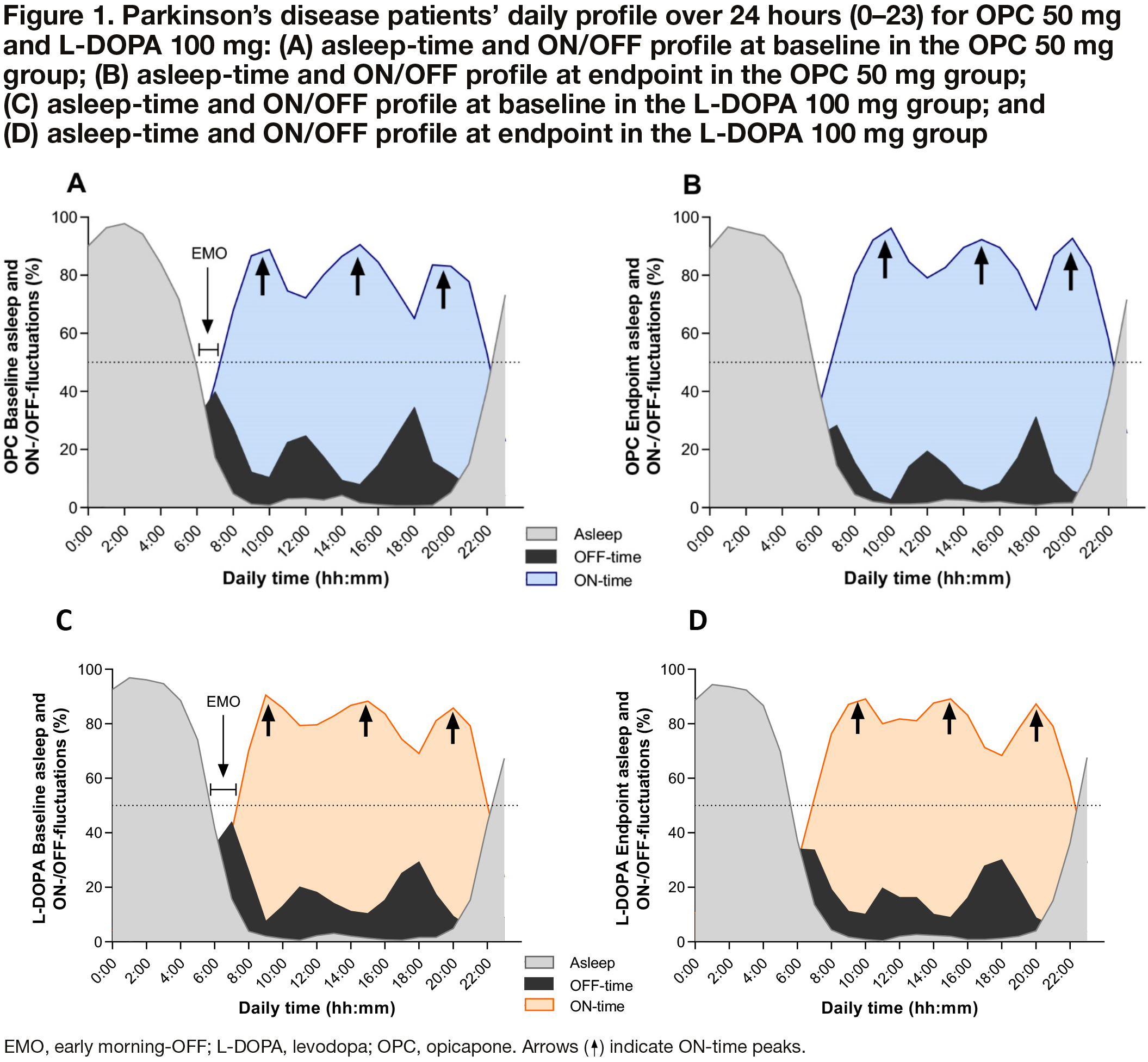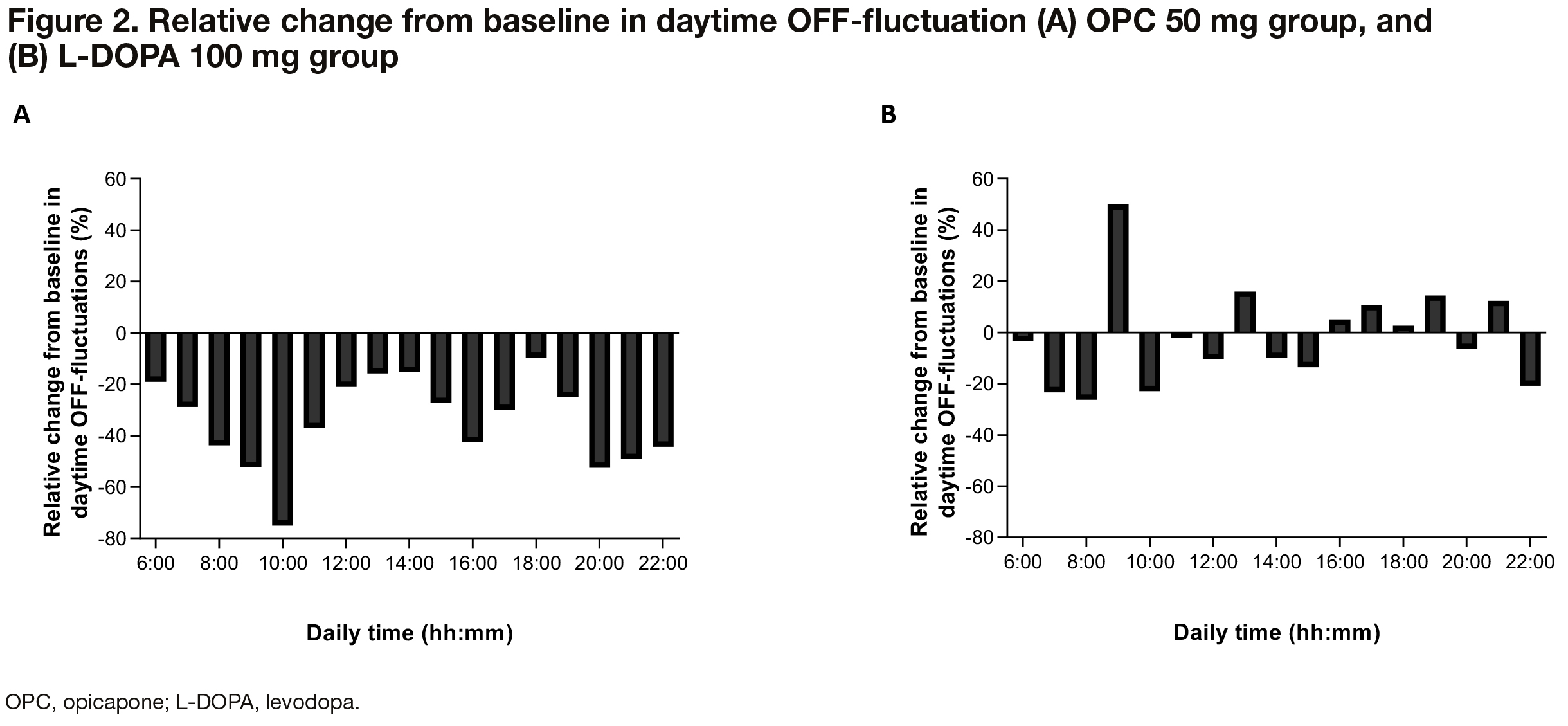Category: Parkinson’s Disease: Clinical Trials
Objective: To evaluate the effect of opicapone (OPC) 50 mg versus an additional 100 mg dose of levodopa (L-DOPA) on ON-/OFF-daily patterns in patients with Parkinson’s disease (PD) and early motor fluctuations.
Background: Clinicians should be familiar with the effect that anti-PD treatments may have on the typical daily patterns of motor fluctuations in patients with PD.
Method: The Korean ADOPTION study evaluated the effects of OPC 50 mg versus an additional 100 mg L-DOPA dose in PD patients with early motor fluctuations treated with L-DOPA/dopa decarboxylase inhibitor. The main endpoint was change from baseline to Week 4 in OFF-time. This post-hoc analysis used patients’ home diaries to assess the effects of OPC 50 mg and L-DOPA 100 mg on ON/OFF daily patterns. Patients’ 24-hour diary data were evaluated per daily hour. Asleep and ON/OFF fluctuations were characterised and depicted by daily hour. Early morning-OFF (EMO) was defined as the morning period for which the percentage of asleep-time per hour was >5% (therefore not negligible) but <50%, and also less than the percentage of OFF-time per hour.
Results: The full analysis set included 165 patients (OPC 50 mg, n=84; L-DOPA 100 mg, n=81). For both groups, at baseline and endpoint, the asleep-time (>50% per hour) was between 10 pm to 6 am [Figure 1]. During ‘daytime’ (6 am–10 pm), for both baseline and endpoint, three distinct OFF/ON transition periods (during which minimum duration in ON-time and maximum duration in OFF-time matched) were identified, consistent with the thrice-daily L-DOPA regimen commonly prescribed to PD patients. No EMO was observed for either group at the study endpoint. The relative reduction in daytime OFF-time was ~35% per available daily hour with OPC 50 mg and ~2% with L-DOPA 100 mg [Figure 2]. A daytime reduction in OFF-time was consistently observed at all hours in the OPC 50 mg group, whereas the addition of L-DOPA 100 mg did not result in daytime OFF-time reduction at all hours [Figure 2].
Conclusion: Adding OPC 50 mg to L-DOPA treatment might have more benefits on motor fluctuations than an additional 100 mg L-DOPA dose. Better and sustained improvements in OFF-time were reported with OPC 50 mg during the 24-hour period when compared to an additional dose of L-DOPA distributed as two 50-mg intakes.
Figure 1
Figure 2
To cite this abstract in AMA style:
J. Lee, J. Ferreira, H. Ma, J. Rocha, B. Jeon. Effect of Opicapone and Levodopa on Daily Motor Patterns in Parkinson’s Disease Patients with Early Motor Fluctuations: Findings from the Korean ADOPTION Study [abstract]. Mov Disord. 2024; 39 (suppl 1). https://www.mdsabstracts.org/abstract/effect-of-opicapone-and-levodopa-on-daily-motor-patterns-in-parkinsons-disease-patients-with-early-motor-fluctuations-findings-from-the-korean-adoption-study/. Accessed October 21, 2025.« Back to 2024 International Congress
MDS Abstracts - https://www.mdsabstracts.org/abstract/effect-of-opicapone-and-levodopa-on-daily-motor-patterns-in-parkinsons-disease-patients-with-early-motor-fluctuations-findings-from-the-korean-adoption-study/


